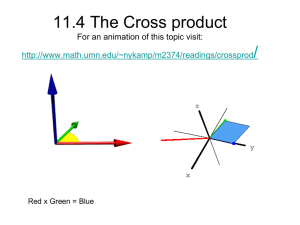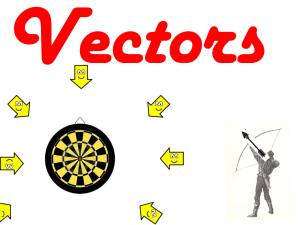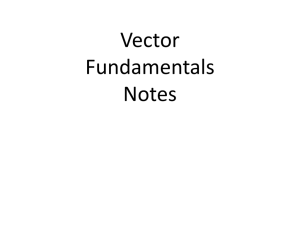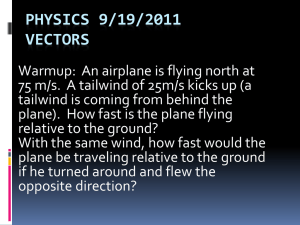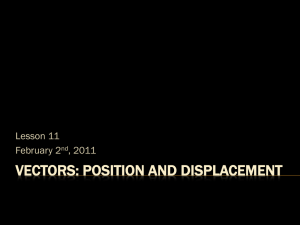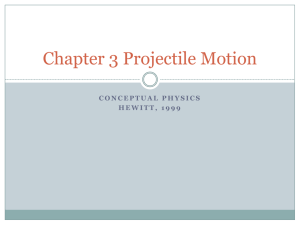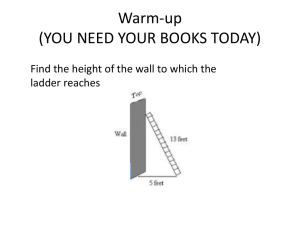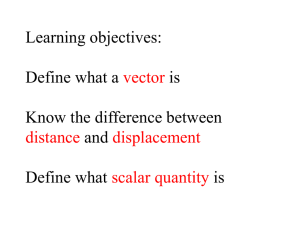Chapter 3
advertisement
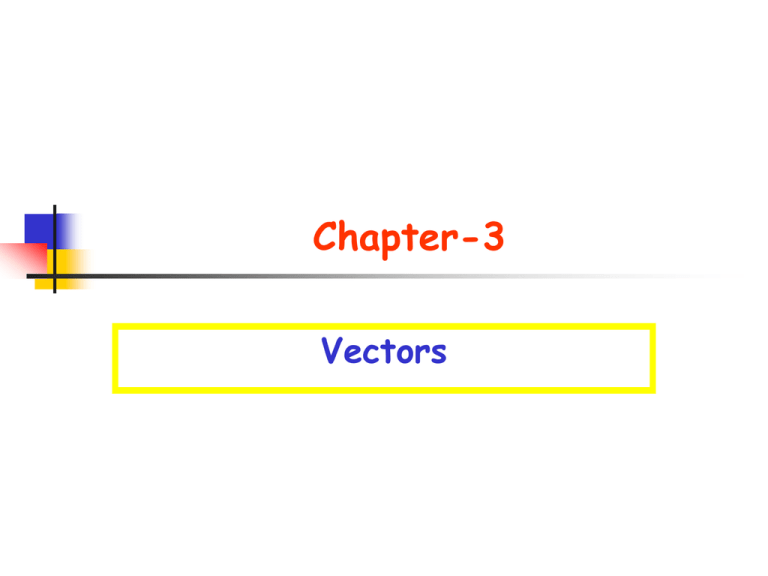
Chapter-3 Vectors Chapter 3 vectors In physics we have Phys. quantities that can be completely described by a number and are known as scalars. Temperature and mass are good examples of scalars. Other physical quantities require additional information about direction and are known as vectors. Examples of vectors are displacement, velocity, and acceleration. In this chapter we learn the basic mathematical language to describe vectors. In particular we will learn the following: Geometric vector addition and subtraction Resolving a vector into its components The notation of a unit vector Addition and subtraction vectors by components Multiplication of a vector by a scalar The scalar (dot) product of two vectors The vector (cross) product of two vectors Ch 3-2 Vectors and Scalars Vectors : Vector quantity has magnitude and direction Vector represented by arrows with length equal to vector magnitude and arrow direction giving the vector direction Example: Displacement Vector Scalar : Scalar quantity with magnitude only. Example: Temperature,mass Ch 3-3 Adding Vectors Geometrically Vector addition: Resultant vector is vector sum of two vectors Head to tail rule : vector sum of two vectors a and b can be obtained by joining head of a vector with the tail of b vector. The sum of the two vectors is the vector s joining tail of a to head of b s=a + b = b + a Ch 3-3 Adding Vectors Geometrically Commutative Law: Order of addition of the vectors does not matter a + b = b + a Associative Law: More than two vectors can be grouped in any order for addition (a+b)+c= a + (b+c) Vector subtraction: Vector subtraction is obtained by addition of a negative vector Check Point 3-1 The magnitude of displacement a and b are 3 m and 4 m respectively. Considering various orientation of a and b, what is i) maximum magnitude for c and ii) the minimum possible magnitude? i) c-max=a+b=3+4=7 a b c-max ii) c-min=a-b=3-4=1 a -b c-min Ch 3-4 Components of a Vector Components of a Vector: Projection of a vector on an axis x-component of vector: its projection on x-axis ax=a cos y-component of a vector: Its projection on y-axis ay=a sin Building a vector from its components a =(ax2+ay2); tan =ay/ax Check Point 3-2 In the figure, which of the indicated method for combining the x and y components of the vector d are propoer to determine that vector? Ans: Components must be connected following headto-tail rule. c, d and f configuration Ch 3-5 Unit Vectors Unit vector: a vector having a magnitude of 1 and pointing in a specific direction In right-handed coordinate system, unit vector i along positive x-axis, j along positive y-axis and k along positive z-axis. a = ax i + ay j + az k ax , ay and az are scalar components of the vector Adding vector by components: r= a+b then rx= ax + bx ; ry= ay + by ; rz= axz+ bz r = rx i+ ry j + rz k Ch 3-6 Adding Vectors by components To add vectors a and b we must: 1) Resolve the vectors into their scalar components 2) Combine theses scalar components , axis by axis, to get the components of the sum vector r 3) Combine the components of r to get the vector r r= a + b a=axi + ay j; ; b = bxi+byj rx=ax + bx; ry = ay + by r= rx i + ry j Check Point 3-3 a) In the figure here, what are the signs of the x components of d1 and d2? b) What are the signs of the y components of d1 and d2? c) What are the signs of x and y components of d1+d2? Ans: a) +, + b) +, c) Draw d1+d2 vector using head-to-tail rule Its components are +, + Ch 3-8 Multiplication of vectors Multiplying a vector by a scalar: In multiplying a vector a by a scalar s, we get the product vector sa with magnitude sa in the direction of a ( positive s) or opposite to direction of a ( negative s) Ch 3-8 Multiplication of vectors Multiplying a vector by a vector: i) Scalar Product (Dot Product) a.b= a(b cos)=b(a cos) = (axi+ayj).(bxi+byj) = axbx+ayby where b cos is projection of b on a and a cos is projection of a on b Ch 3-8 Multiplication of vectors Since a.b= ab cos Then dot product of two similar unit vectors i or j or k is given by : i.i=j.j=k.k=1 (=0, cos=1) is a scalar Also dot product of two different unit vectors is given by: i.j=j.k=k.i =0 (=90, cos=0). Check Point 3-4 Vectors C and D have magnitudes of 3 units and 4 units, respectively. What is the angle between the direction of C and D if C.D equals: a) Zero b) 12 units c) -12 units? a) Since a.b= ab cos and a.b=0 cos =0 and = cos-1(0)=90◦; (b) a.b=12, cos =1 and = cos-1(1)=0◦ (vectors are parallel and in the same direction) (c) b) a.b=-12, cos =-1 and = cos-1(-1)=180◦ (vectors are in opposite directions) Ch 3-8 Multiplication of vectors Multiplying a vector by a vector: ii) Vector Product (Cross Product) c= ax b = absin c = (axi+ayj)x(bxi+byj) Direction of c is perpendicular to plane of a and b and is given by right hand rule Ch 3-8 Multiplication of vectors Since a x b= ab sin is a vector Then cross product of two similar unit vectors i or j or k is given by : ixi= jxj = kxk =0 (as =0 so sin =0). Also cross product of two different unit vectors is given by: ixj=k; jxk= i ; kxi =j jxi= -k; kxj= -i ; ixk=-j Ch 3-8 Multiplication of vectors If a=axi +ayj and b=bxi+byj Then c = axb =(axi +ayj )x(bxi+byj) = axi x (bxi +byj) + ayj (bxi+byj) = axbx(i x i ) + axby(i x j) + aybx(jx i ) + ayby(j x j) but ixi=0, ixj=k; jxi=-k Then c=axb = (axby-aybx) k Check Point 3-5 Vectors C and D have magnitudes of 3 units and 4 units, respectively. What is the angle between the direction of C and D if magnitude of C x D equals: a) Zero b) 12 units a) Since a xb= ab sin and axb=0 sin =0 and = sin-1 (0) =0◦, 180◦ (b) a xb =12, sin =1 and = sin-1(1)=90◦
